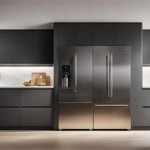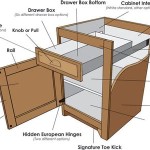Modern Green Kitchen Ideas: Integrating Sustainability and Style
The modern kitchen is increasingly becoming a focal point for sustainable living, reflecting a broader societal shift towards environmental consciousness. Incorporating green principles into kitchen design is not merely a trend, but a responsible approach to resource management, waste reduction, and the creation of a healthier living environment. Green kitchen design blends functionality with environmental responsibility, aiming to minimize ecological impact while maximizing aesthetic appeal and practicality. This article will explore various modern green kitchen ideas, focusing on materials, appliances, layout, and lifestyle choices that contribute to a more sustainable and eco-friendly culinary space.
Sustainable Materials: The Foundation of a Green Kitchen
The selection of materials is paramount in creating a green kitchen. Choosing eco-friendly and sustainable options minimizes the environmental footprint associated with construction and renovation. These materials range from recycled content to sustainably harvested wood, contributing to a circular economy and reducing reliance on virgin resources.
Countertops: Traditional countertop materials like granite and quartz, while durable, require extensive mining and processing. Sustainable alternatives include recycled glass countertops, which utilize post-consumer glass and require less energy to produce. Bamboo countertops are another excellent option, as bamboo is a rapidly renewable resource that regenerates quickly after harvesting. Concrete countertops, if produced with recycled aggregates and supplementary cementitious materials, can also be a sustainable choice, reducing the carbon footprint associated with cement production. Reclaimed wood countertops offer unique character and prevent deforestation by repurposing existing lumber.
Cabinets: Kitchen cabinets constitute a significant portion of material usage in a kitchen, making their selection crucial for sustainable design. Cabinets made from reclaimed wood are a prime choice, offering a rustic aesthetic while diverting materials from landfills. Wood certified by the Forest Stewardship Council (FSC) ensures that the timber comes from responsibly managed forests that uphold environmental and social standards. Using formaldehyde-free plywood or particleboard for cabinet construction minimizes the release of volatile organic compounds (VOCs) into the indoor air, promoting a healthier environment. Bamboo cabinets are also gaining popularity due to bamboo's rapid growth and renewability. Additionally, consider cabinets finished with low-VOC or zero-VOC paints and stains to further reduce indoor air pollution.
Flooring: The choice of flooring significantly impacts the overall sustainability of the kitchen. Cork flooring is a renewable and sustainable option, harvested from the bark of cork oak trees without harming the tree itself. Bamboo flooring provides similar benefits to bamboo countertops, being a rapidly renewable resource. Linoleum, made from natural materials like linseed oil, cork dust, and wood flour, is a durable and biodegradable option. Recycled glass tiles or reclaimed wood flooring can also add unique character while reducing waste. When selecting flooring adhesives and sealants, opt for low-VOC or water-based products to minimize off-gassing.
Backsplash: Sustainable backsplash options include recycled glass tiles, which come in a variety of colors and designs, offering aesthetic flexibility. Ceramic tiles made from recycled content are another viable option. Natural stone, when sourced responsibly from local quarries, can minimize transportation emissions. Bamboo panels or reclaimed wood can also be used for a unique and eco-friendly backsplash.
Energy and Water Efficiency: Minimizing Environmental Impact
Beyond material selection, energy and water efficiency are essential components of a green kitchen. Implementing energy-efficient appliances and water-saving fixtures significantly reduces the kitchen's environmental footprint and lowers utility bills.
Energy-Efficient Appliances: Energy Star-certified appliances are designed to consume less energy than standard models, reducing electricity usage and greenhouse gas emissions. Replacing older appliances with Energy Star-rated refrigerators, dishwashers, and ovens can lead to significant energy savings over their lifespans. Induction cooktops are more energy-efficient than traditional electric or gas cooktops, as they directly heat the cookware rather than the surrounding air. LED lighting is another crucial component of energy efficiency, consuming significantly less energy than incandescent or fluorescent bulbs. Smart appliances offer features like energy usage monitoring and remote control, allowing for further optimization of energy consumption.
Water-Saving Fixtures: Installing low-flow faucets and showerheads reduces water consumption without sacrificing performance. Look for fixtures with WaterSense certification, which indicates that they meet EPA criteria for water efficiency. Consider installing a dual-flush toilet or a composting toilet to further reduce water usage. Repairing leaky faucets and pipes promptly prevents water waste and minimizes the overall water footprint of the kitchen. Greywater systems can be implemented to reuse water from sinks and dishwashers for non-potable purposes, such as watering plants or flushing toilets.
Natural Light and Ventilation: Maximizing natural light reduces the need for artificial lighting, saving energy and creating a more pleasant kitchen environment. Strategically positioning windows and skylights can significantly increase natural light penetration. Natural ventilation, facilitated by operable windows and doors, reduces the need for air conditioning, saving energy and improving indoor air quality. Consider installing a range hood with an efficient fan to remove cooking fumes and odors, improving ventilation and indoor air quality.
Lifestyle Choices: Cultivating Sustainable Habits
Beyond material and appliance choices, adopting sustainable lifestyle habits in the kitchen is crucial for minimizing environmental impact. These habits range from waste reduction and composting to mindful food consumption and responsible cleaning practices.
Waste Reduction and Recycling: Minimizing waste generation is a core principle of sustainable living. Reduce reliance on single-use plastics by using reusable shopping bags, food containers, and water bottles. Properly sorting and recycling materials such as paper, plastic, glass, and metal reduces landfill waste and conserves resources. Compost food scraps and yard waste to create nutrient-rich soil for gardening, diverting organic waste from landfills. Consider implementing a vermicomposting system for indoor composting. Avoid purchasing products with excessive packaging and opt for products packaged in recyclable or compostable materials.
Composting: Composting is an essential practice for diverting food waste from landfills. Food scraps, coffee grounds, and yard waste can be composted either outdoors in a traditional compost bin or indoors using a vermicomposting system. Composting reduces greenhouse gas emissions associated with landfill decomposition and creates nutrient-rich compost for gardening.
Mindful Food Consumption: Reducing food waste is a significant aspect of sustainable living. Plan meals carefully to avoid overbuying and spoilage. Store food properly to extend its shelf life. Use leftovers creatively in new dishes. Support local farmers and producers to reduce transportation emissions and promote sustainable agriculture. Grow herbs and vegetables in a kitchen garden to reduce reliance on conventionally grown produce. Avoid purchasing food from unsustainable sources and opt for sustainably harvested seafood and organically grown produce.
Eco-Friendly Cleaning Products: Conventional cleaning products often contain harsh chemicals that can pollute indoor air and harm the environment. Opt for eco-friendly cleaning products made from natural ingredients and free of harmful chemicals like chlorine, ammonia, and phosphates. Consider making your own cleaning products using simple ingredients like vinegar, baking soda, and lemon juice. These homemade cleaning solutions are effective, affordable, and environmentally friendly. Using reusable cleaning cloths and sponges reduces reliance on disposable paper towels and sponges.
Water Conservation Habits: Beyond installing water-saving fixtures, adopting water conservation habits is crucial for minimizing water usage. Avoid running the water continuously while washing dishes or brushing teeth. Scrape food scraps into the trash or compost before washing dishes. Only run the dishwasher when it is fully loaded. Use a broom instead of a hose to clean outdoor areas. Collect rainwater for watering plants.
Incorporating these green kitchen ideas into the design and management of culinary spaces contributes to a more sustainable and environmentally responsible lifestyle. By prioritizing sustainable materials, energy and water efficiency, and mindful lifestyle choices, individuals can create kitchens that are not only aesthetically pleasing and functional but also environmentally conscious and beneficial for both present and future generations.

Top Green Kitchen Design Ideas 2024 My Specialist

40 Green Kitchen Ideas For A Fresh Makeover

19 Modern Green Kitchen Design Ideas You Should Try In 2025

Green Kitchen Cabinets A Detailed Exploration Oppein

Green Kitchens 33 Inspiring Kitchen Ideas

Green Kitchen Ideas Oppolia

27 Designer Approved Green Kitchen Cabinet Ideas For 2025

9 Green Kitchens That Are Positively On Trend

7 Modern Green Kitchen Cabinets To Elevate Your Space Naturally

Green Kitchen With Dark Cabinets Ideas July 2025
Related Posts








